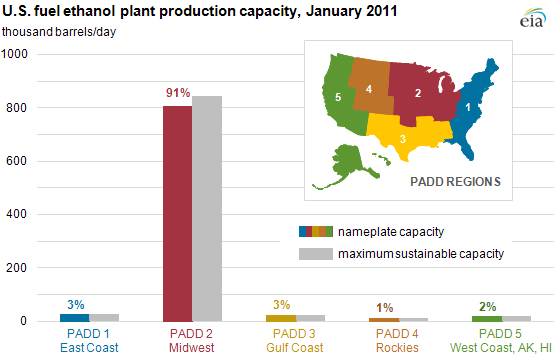
EIA releases U.S. fuel ethanol production capacity data

Note: % = percent of total U.S. nameplate capacity.
Download CSV Data
On November 29, EIA released its first annual report on U.S. fuel ethanol production capacity. The report includes data for the total production capacity for all operating fuel ethanol production plants at the start of 2011. The report will be updated annually.
The report contains both the nameplate and maximum sustainable capacities of fuel ethanol plants by Petroleum Administration for Defense District (PADD). Nameplate capacity is the volume of denatured (made unfit for human consumption) fuel ethanol that can be produced during a period of 12 months under normal operating conditions. Maximum sustainable capacity is the annualized maximum denatured fuel ethanol production that can be achieved over a period of any 6 consecutive months. The total nameplate and maximum sustainable production capacities in the report are listed by PADD in both millions of gallons per year and thousands of barrels per day.
The report shows the total U.S. fuel ethanol nameplate capacity of 13.6 billion gallons per year (888 thousand barrels per day). The majority of U.S. fuel ethanol production capacity, about 91%, is located in PADD 2. Total nameplate capacity in PADD 2 is 12.4 billion gallons per year (807 thousand barrels per day).
The capacity data are reported to EIA by respondents on the EIA-819 Monthly Oxygenate Report. The EIA-819 is submitted by all operating fuel ethanol and other oxygenate production plants within the United States. The published ethanol production capacity includes only the ethanol plants that were operating as of January 1, 2011, and does not include plants that were idled or shut down as of that date.
Tags: renewables, liquid fuels, ethanol, alternative fuels, oil/petroleum, states, biofuels, daily, AEO2011